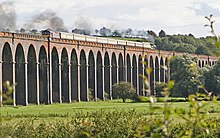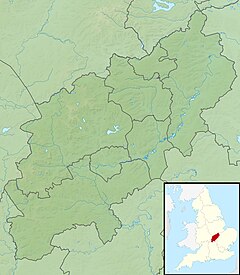Welland Viaduct
| Welland Viaduct | |
|---|---|
 |
|
| Coordinates | 52°34′1″N 0°39′14″W / 52.56694°N 0.65389°WCoordinates: 52°34′1″N 0°39′14″W / 52.56694°N 0.65389°W |
| OS grid reference | |
| Carries | Oakham to Kettering Line |
| Crosses | River Welland |
| Locale | Northamptonshire – Rutland |
| Official name | Welland Viaduct |
| Maintained by | Network Rail |
| Heritage status | Grade II listed |
| Characteristics | |
| Total length | 1,275 yd (1.166 km) |
| Height | 60 ft (18 m) maximum |
| History | |
| Opened | 1878-1880 |
Welland Viaduct, also known as Harringworth Viaduct and Seaton Viaduct, is a railway viaduct which crosses the valley of the River Welland between Harringworth in Northamptonshire and Seaton in Rutland, England.
It is 1,275 yards (1.166 km) long and has 82 arches, each of which has a 40 feet (12 m) span. The viaduct was built by Lucas and Aird and completed in 1878. It is the longest masonry viaduct across a valley in Britain and a Grade II listed building.
Welland Viaduct lies on the Oakham to Kettering Line and carries the twin track non-electrified line between Corby and Manton Junction, where it joins the Leicester to Peterborough line. The route is generally used for the passage of freight trains and steam train outings. In early 2009, a single daily passenger service was introduced by East Midlands Trains between Melton Mowbray and St Pancras via Corby, the first regular daily passenger service to operate across the viaduct since the 1960s. The viaduct is also used as a diversionary route for East Midlands Trains mainline services using the Midland Main Line route. The line and structure, dominating this picturesque rural valley, are a favourite with steam train and heritage enthusiasts alike.
The first brick was laid in March 1876 and the last arch was finished in July 1878.
Due to the structure's size, age, exposure and inaccessibility, the original brickwork was suffering from extensive weathering and structural deterioration. As part of the Network Rail Structures maintenance programme, Birse Rail was remitted to carry out structural repairs to the viaduct. Traditional methods and materials were employed alongside modern access techniques to return the structure to its former glory and to ensure the long-term structural integrity of the viaduct, as well as the enjoyment of generations to come.
...
Wikipedia



